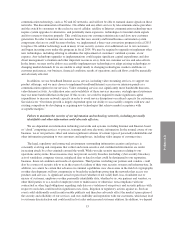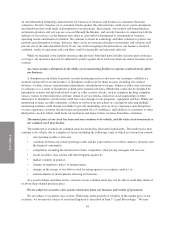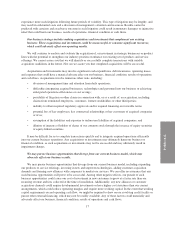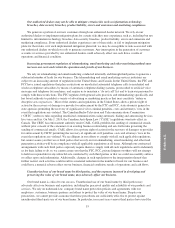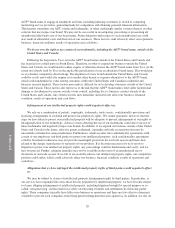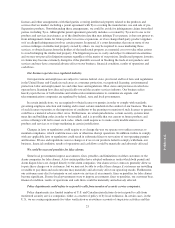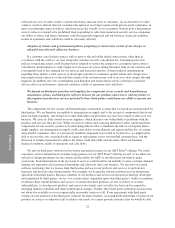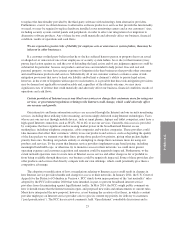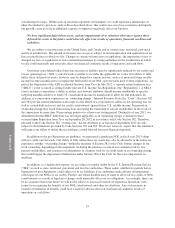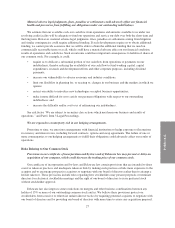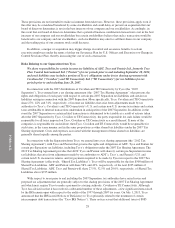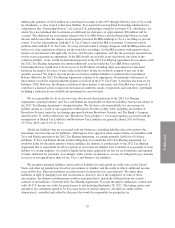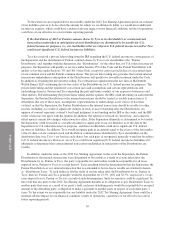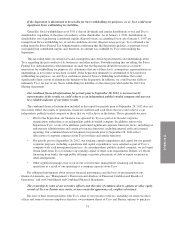ADT 2014 Annual Report Download - page 89
Download and view the complete annual report
Please find page 89 of the 2014 ADT annual report below. You can navigate through the pages in the report by either clicking on the pages listed below, or by using the keyword search tool below to find specific information within the annual report.
FORM 10-K
to replace the functionality provided by the third-party software with technology from alternative providers.
Furthermore, even if we obtain licenses to alternative software products or services that provide the functionality
we need, we may be required to replace hardware installed at our monitoring centers and at our customers’ sites,
including security system control panels and peripherals, in order to affect our integration of or migration to
alternative software products. Any of these factors could materially and adversely affect our business, financial
condition, results of operations and cash flows.
We are exposed to greater risks of liability for employee acts or omissions or system failure, than may be
inherent in other businesses.
If a customer or third party believes that he or she has suffered harm to person or property due to an actual
or alleged act or omission of one of our employees or security system failure, he or she (or their insurers) may
pursue legal action against us, and the cost of defending the legal action and of any judgment against us could be
substantial. In particular, because our products and services are intended to help protect lives and real and
personal property, we may have greater exposure to litigation risks than businesses that provide other consumer
and small business products and services. Substantially all of our customer contracts contain a series of risk-
mitigation provisions that serve to limit our liability and/or limit a claimant’s ability to pursue legal action;
however, in the event of litigation with respect to such matters, it is possible that these risk-mitigation provisions
may be deemed not applicable or unenforceable and, regardless of the ultimate outcome, we may incur
significant costs of defense that could materially and adversely affect our business, financial condition, results of
operations and cash flows.
Certain providers of Internet access may block our services or charge their customers more for using our
services, or government regulations relating to the Internet could change, which could adversely affect
our revenue and growth.
Our interactive and home automation services are accessed through the Internet and our security monitoring
services, including those utilizing video streaming, are increasingly delivered using Internet technologies. Users
who access our services through mobile devices, such as smart phones, laptops and tablet computers, must have a
high-speed Internet connection, such as Wi-Fi, 3G or 4G, to use our services. Currently, this access is provided
by companies that have significant and increasing market power in the broadband and Internet access
marketplace, including telephone companies, cable companies and wireless companies. These providers could
take measures that affect their customers’ ability to use our products and services, such as degrading the quality
of the data packets we transmit over their lines, giving those packets low priority, giving other packets higher
priority than ours, blocking our packets entirely or attempting to charge their customers more for using our
products and services. To the extent that Internet service providers implement usage based pricing, including
meaningful bandwidth caps, or otherwise try to monetize access to their networks, we could incur greater
operating expenses and customer acquisition and retention could be negatively impacted. Furthermore, to the
extent network operators were to create tiers of Internet access service and either charge us for or prohibit us
from being available through these tiers, our business could be negatively impacted. Some of these providers also
offer products and services that directly compete with our own offerings, which could potentially give them a
competitive advantage.
The adoption or modification of laws or regulations relating to Internet access could result in changes in
how Internet service providers handle and charge for access to their networks. In January 2014, the U.S. Court of
Appeals for the District of Columbia in Verizon v. FCC struck down major portions of the “net neutrality” rules
adopted by the FCC in December 2010 that were intended, in part, to prevent broadband internet service
providers from discriminating against legal Internet traffic. In May 2014, the FCC sought public comment on
how it should ensure that the Internet remains open, and proposed new rules and enhancements to current rules.
Many have interpreted the new proposal, however, as not banning the creation of fast lanes, in which a content
provider might pay an Internet service provider a fee to give its content top priority for delivery to customers
(“paid prioritization”). The FCC has received comments, held “Open Internet” roundtable discussions and is
23




